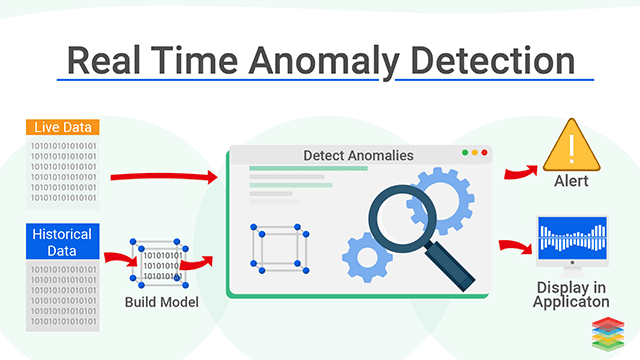One exceptional feature of human sight is ‘difference’ detection. When something gets changed from the usual, the eye detects it instantly, may it be a new haircut, an unusual colour worn by someone, a new painting brought in the house or even flowers changed in a flower pot. Eye recognises that something is different. Sometimes, even when the brain refuses to comprehend the difference, the eye keeps on searching until it finds its solution. Anomaly detection, too, is synonymous with human sight and works on the same principle. It instantly catches the unusual or abnormal event, which we call an anomaly. So, an anomaly in easy words is anything different from the usual pattern.
What is Anomaly Detection?
Let’s try to understand Anomaly detection in simpler terms first. Sometimes, we get some unusual patterns in our data that do not resemble the regular data pattern. So, finding those abnormalities or anomalies that do not comply with the standard data flow is termed anomaly detection.
Hence, anomaly detection identifies unusual events, unexpected observations, or items that differ significantly from the standard behaviour of the dataset. While analysing real-world data sets, sometimes, some data points stand out to all other data points. Such data points are called anomalies. Therefore, anomaly detection is nothing but identifying all such data points in a data-driven model and deciding whether data points are normal or abnormal. Anomaly detection is the task of determining a boundary around the usual data points to distinguish them from the outliers (anomalies). Anomalies are also termed as outliers, novelties, noise, exceptions or deviations. Thus, Anomaly Detection is also known as Outlier Analysis.
Traditional Anomaly Detection Systems Vs. AI-Powered Anomaly Detection Systems
Anomaly detection systems are manually built up by experts. The programmers either set a threshold for the data or it is automatically constructed from the available data through machine learning.
Traditional Anomaly Detection Systems – Traditional anomaly detection is manual, but building an anomaly system by hand is very tedious. The domain knowledge also requires a futuristic approach and keen foresight, but its scope remains limited. Manual anomaly detection cannot adapt on its own. When a system fails, the builder needs to add other security methods manually, proving to be highly expensive. This is not a wise option in an ecosystem where the data changes over time.
AI-Powered Anomaly Detection Systems – With Artificial Intelligence techniques, the possibilities of anomaly detection are becoming infinite. Anomaly detectors techniques are gradually raising their bars of standard with machine learning. In this data-driven world, where we have uncountable items to watch, anomaly detection can:
- Help to discover the error point occurrence
- Anticipate the root cause analysis
- Notify the tech support on the issue
- Get the responsible parties to act with immediate effect.
AI-powered anomaly detection systems –
- Can handle large datasets
- Are adaptive in nature and
- Are more efficient
Significance of Anomaly Detection in the Modern World
Circumstances have altered, and in today’s technological world, the majority of business decisions are data-driven. Hence, anomaly detection becomes crucial to safeguard the data and keep a strict check on any anomaly. Data errors generally cause anomalies, but sometimes they indicate a new (previously unknown) underlying error. Most of the time, the anomalous data is related to a technical glitch or, in rare cases like hacking, bank fraud, data malfunctioning, infrastructure failures, etc. So, it becomes utterly crucial to identify the actual anomalies from the data noises/false positives. The efficiency of anomaly detection technology relies upon artificial intelligence to quickly identify abnormal behaviour from the data pool without any mistake.
Future of Anomaly Detection and Applications of Anomaly Detection in the Modern World
Currently, numerous industries use anomaly detection, and it has been successfully applied to enhance their operations. According to MarketsandMarkets, the anomaly detection market is expected to cross $4.45 billion by 2022.
The technology and technique of anomaly detection are still exploring their possibilities. Still, one thing is sure that it will have tremendous prospects when it grows, or we can say the sky would be the limit. Seeing the prosperous future, there has been a sudden rise in AI and ML courses. Several current generation students and professionals are promptly taking them up as their considerable prospects.
The most popular applications of anomaly detection in today’s world are:
- Fraud detection in financial transactions
- Detect Network Intrusion
- Detection of rare events exhibiting anomalous data
- Data Cleaning
- Damage detection in industries
- Detection of the misinformation or fake news on the internet
- Health monitoring systems
- Fault detection in operating systems
- Ecosystem disturbances
Categories of Anomalies
Anomalies are broadly categorised as:
- Point Anomalies– In a given dataset, if a single instance is different/far off from the rest of the data point, it is called a point anomaly. It is also referred to as a Global Outlier. Example- Detection of financial frauds like credit card fraud, based on ‘amount spent’ is an example of point anomaly.
- Contextual Anomalies- A data point is considered a contextual anomaly if its value deviates chiefly from the rest of the data point in some observation context. It is essential to note that the meaning of ‘context’ here means that the same value may not be considered an anomaly if it occurs in a different context. This type of anomaly is common in time-series data, and it is also known as a Conditional Outlier. Example – Power consumption has a contextual-based time-related relationship. It is evident that the power consumption in an office building is maximum during mid-day or a workday compared to at night or during an off-day.
- Collective Anomalies- Collective anomalies are the data points considered anomalies when viewed with other data points concerning the rest of the datasets. For example, if someone is unexpectedly trying to copy data from a remote machine to a local host, it might be a potential cyber attack.
Anomaly Detection with the Use of Artificial Intelligence
Anomaly detection is growing tremendously with the aid of artificial intelligence. As we all know, AI is the emerging future of technology, and this fact is well acknowledged by the education industry. Today, several prestigious technical universities worldwide are providing online artificial intelligence degrees, and many professionals are readily taking them up to upgrade their sphere of knowledge. With the help of AI courses, professionals worldwide are developing more workable and efficient AI-powered solutions.
Anomaly detection has to become more operative and powerful with machine learning. Two machine learning techniques can enable effective anomaly detection.
1. SUPERVISED ANOMALY DETECTION – This method requires a labelled dataset containing both normal and abnormal samples to construct a predictive model and classify future data points. The most commonly used algorithms for this process are supervised neural networks, support vector machine learning, K-Nearest Neighbors Classifier, etc.
2. UNSUPERVISED ANOMALY DETECTION – This method assumes only two things about the data. It is believed that only a small percentage of data is anomalous, and it is statistically unlike the standard samples. Following these two assumptions, the data is clustered using a similarity measure, and the data points far off from the cluster are considered anomalies.
Conclusion
We hope this article aids you to understand the basics of Anomaly Detection and the role of Artificial Intelligence in Anomaly Detection. AI is the future of technology, and here is your chance to be the forerunner in this new emerging world of Artificial Intelligence. Be future-ready by taking up an online Artificial Intelligence degree today from the prestigious university.

























